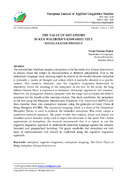| dc.contributor.author | Ntabo, Victor Ondara | |
| dc.date.accessioned | 2019-04-11T08:40:35Z | |
| dc.date.available | 2019-04-11T08:40:35Z | |
| dc.date.issued | 2019 | |
| dc.identifier.citation | European Journal of Applied Linguistics Studies, Volume 1, Issue 2, 2019 | en_US |
| dc.identifier.issn | 2602 - 0254 | |
| dc.identifier.uri | https://karuspace.karu.ac.ke/handle/20.500.12092/2234 | |
| dc.description | doi.org/10.5281/zenodo.2544569 | en_US |
| dc.description.abstract | The novelist Ken Walibora employs metaphors in his Kiswahili text Kidagaa Kimemwozea to discuss about the subject of neocolonialism in different perspectives. Due to the metaphoric language used, meaning might be elusive to the readers because metaphor is primarily a matter of thought and action which is normally situated in a specific context. This research, therefore, uses the Cognitive Linguistics framework to objectively reveal the meaning of the metaphors in the text. In the novel, the king (Mtemi Nasaha Bora) is expressed as irrational, dictatorial, oppressive and amorous. However, the protagonist (Amani) conspires with the king’s son to exploit the father’s weakness for the benefit of the common citizens. This study establishes the metaphors in the text using the Metaphor Identification Procedure Vrije Universiteit (MIPVU) and then classifies them into conceptual domains using the principle of Great Chain of Being Metaphor (GCBM). The conceptual mapping which is a tenet of the Conceptual Metaphor Theory is used to evaluate the identified metaphors. This study adopts a qualitative research approach. The paper reveals that animals, plants and objects are stratified source domains richly used to depict the characters in the novel. For a better appreciation of metaphors, the research recommends that it is salient to use the cognitive linguistics approach to understand contextual language against the cultural, historical and geographical backdrop. The paper concludes that metaphors are vital tools of communication and should be explained using the cognitive linguistics approach. | en_US |
| dc.language.iso | en | en_US |
| dc.publisher | European Journal of Applied Linguistics Studies | en_US |
| dc.subject | metaphor | en_US |
| dc.subject | cognitive linguistics, | en_US |
| dc.subject | conceptual mapping, | en_US |
| dc.subject | The Great Chain of Being metaphor, | en_US |
| dc.subject | Kidagaa Kimemwozea | en_US |
| dc.title | The Value of Metaphors in Ken Walibora’s Kiswahili Text: ‘Kidagaa Kimemwozea’ | en_US |
| dc.type | Article | en_US |
